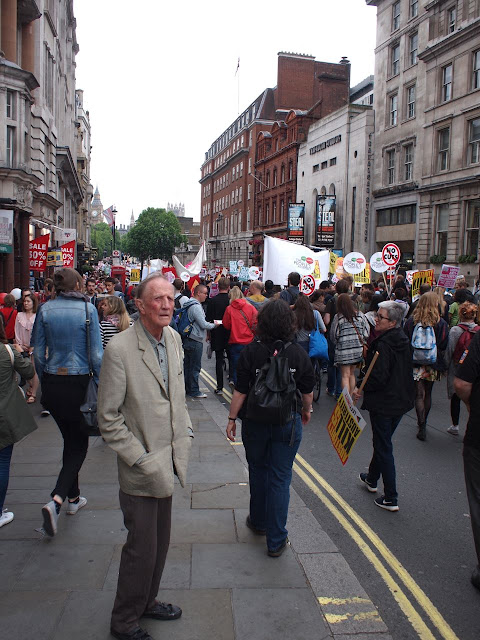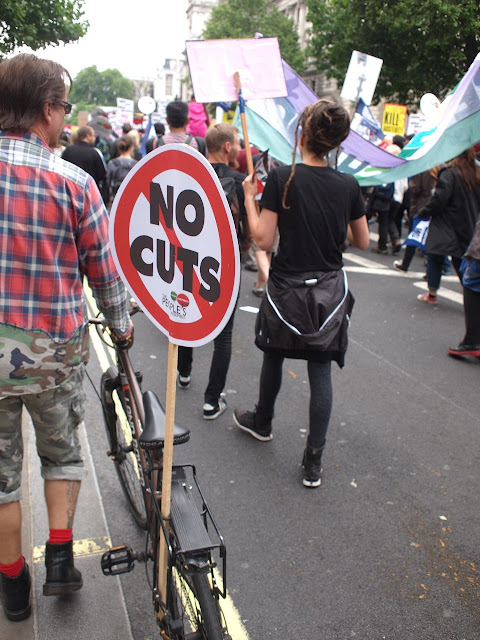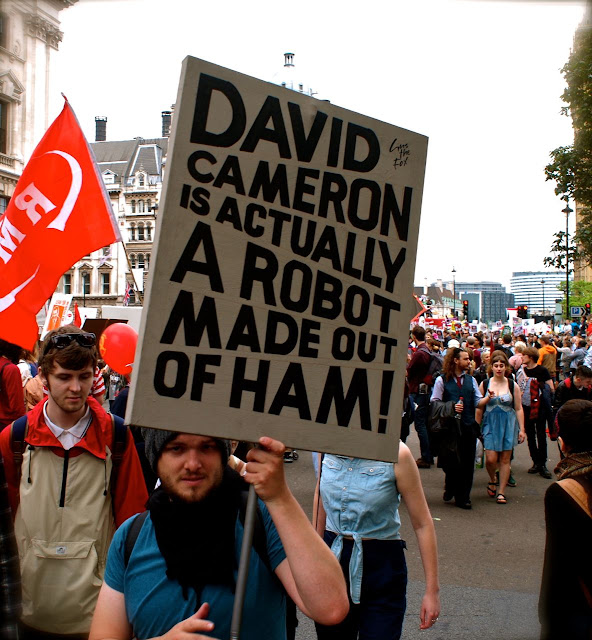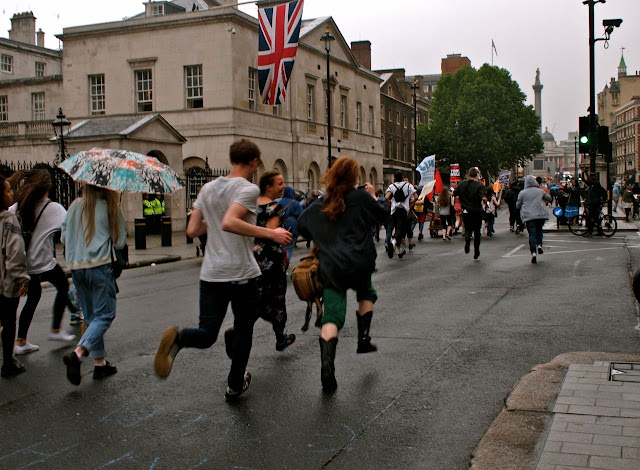 |
| Wandsworth Road Overground station: this where I and other Clapham bumpkins can jump on a train to get to places such as Shoreditch where I can gawp at beautiful young hipsters. But it used to be an even more useful station. |
So as promised I get my hands on
Iain Sinclair's new book, London Overground: A Day's Walk Around the Ginger Line, and immediately commit the unspeakable crime of jumping straight to the bits about my home turf - the stretch of this more orange than ginger line between Denmark Hill and Clapham Junction.
Oh my god, he's walking through Will Self's manor, but by god he does it with style.
I think I did Sinclair a disservice in the previous entry. His chapter on Angela Carter is superb, unusually warm for him ( but perhaps he is softening in his late middle age?) and also fairly uncomplicated.
He relates various encounters with the writer over several decades - from earliest meetings when, as a secondhand book-dealer and aspiring writer, he went to her house to buy a load of surplus signed first editions left over from book signings.
Then there was the time of her high-profile review of his novel
Downriver in the
London Review of Books, in which - if I remember it rightly - she confesses to finding the East End quite alien and scary, what with its bustling streets and wide pavements.
And so on through the decades to the publishing and literary prize parties of her later career, right up to her death in 1992.
This new orbital route through London's inner suburbs - a zone 2 railway version of the M25 - is also a sort of literary merrygoround. Sinclair uses it to link Angela Carter to J G Ballard and his dystopian novels of the near future, set in places like Chelsea Harbour (Imperial Wharf station); thence to Michael Moorcock (the bard of W11, author of Mother London, etc, who nevertheless grew up in Norbury) and Muriel Spark (Peckham Rye, Ballad of…), all as he says strewn along the Overgound line like carelessly scattered pearls.
He speculates on how the line might have affected Carter's work, had she lived. It seems odd to me that the Overground actually leapfrogs over the heartland of her fiction, which I always imagine to be a mix of Camberwell, Herne Hill, Brixton and Lavender Hill.
It's not just me, is i,t who find it odd that the trains do not stop in Brixton? But maybe this is in reality a mercy for Brixton, maybe it will be spared the blandification that this Ginger Line appears to be bringing to some of the neighbourhoods it serves. A visit to a metal-bashing garage under the arches of Loughborough Junction last week made me think all is not lost in this area, and that there's still some space for dread beat and blood style living in SW9; the world of the Magic Toyshop is not completely dead, nor completely swept to the outermost suburbs.
But that's just sentimental, dear: look what they're planning for the nearby estate.
But, back to Carter. I often saw her, and literally bumped into her in the local Arundel Newsagents several times. I always wanted to say something to my literary heroine but never had the nerve. She sometimes smiled, though.
So, swiftly, back to the case in hand. I can't help wondering, as he and his companion strode along from Wandsworth Road station to The Chase, if Sinclair's literary divining rod dipped at any point as it picked up, then lost, the faint traces of CAR Hills, the recently re-incarcerated writer of short fiction, reviews and other journalism, perhaps best known for his Clapham Omnibus column in
Prospect magazine, back in the early 2000s.
Known to many locals as "Prince Charles of the Wandsworth Road", Hills would trudge up and down this drag many times a day, often heading for free lunches at various church halls, or off to one or other of his grim, short-lived employments. Or, on a Monday evening, on his way to my flat for white wine, Bombay mix and Marlene Dietrich records.
Had he lived in Hackney, I've no doubt he'd have ended up as a vaguely sinister character in one of Sinclair's works.
But that's a different entry: I must get back to this wretched Overground. Sinclair bemoans the loss of the old Dalston Juntion to Broad Street commuter line. Here we have a similar grudge to bear. When CAR Hills lived here, what is now the Clapham to Peckham stretch of the Overgorund was part of the the delightfully underused Victoria to London bridge loop, a splendid alternative to the heaving Northern Line which hardly anyone seems to know about. Those little two-carriage trains got me to work in Wapping in relative comfort, the final walk over Tower Bridge capping the pleasant journey.
OK, so now I can get to the Whitechapel Art Gallery and Brick Lane in double-quick time. And yes I am that Clapham bumpkin he mentions. We feel all the more like a wrong-side-of-tracks community these days. Rather than enjoying South London for what it is, the newcomers are trying very hard to turn their bits into honorary North London outposts. It has already happened to much of Battersea and Clapham, Vauxhall, Southwark and Bermondsey, Elephant and Peckham are following on very fast.
 |
You'd never know, would you, that this house
has an interior straight out of the 1001
Nights….575 Wandsworth Road, now
a National Trust property |
Old Vauxhall and parts of Stockwell now exist virtually under the shadow of the new wall of the Nine Elms Lane apartment blocks.
I like to imagine Sinclair and his mate glancing at the twin towers of Wandsworth Road, and wonder if they sensed the heavy, looming horrors of that massive property development just over the tracks. Poor, emasculated Battersea Power Station, its power removed, awaiting its new lightweight safe chimneys. As for the new 'affordable' housing and the promised linear park, well, I've not ever seen more oppressive architecture, not even in the suburbs of St Petersburg.
Sinclair and his companion will also have walked past
575 Wandsworth Road, the extraordinarily
but I don't think there's a mention of this or its eccentric, multitalented owner. The house is now owned by the National Trust, open to visitors on a strictly limited basis.
decorated former home of the late poet, philosopher and civil servant, Khadambi Asalache (1935-2006),
But there's a mention of a Wandsworth Road junk shop where Sinclair's friend bought a "Bruce Chatwin draught excluder", something I can not even begin to visualise. (Shit, he means a book!)
But I do wonder if they went into my friend's shop (more of a vintage clothes and records shop than junk, or at least that's what I like to think), Eclectica; of course there are several other "junk shops" along this road.
I'm also excited that he gives an honourable mention to Russells, the British motorcycle spares shop in Falcon Road, which always makes me think of leather jackets, goggles, Up The Junction, early 1960s bikers racing over Chelsea Bridge on their BSA Gold Stars and Norton Featherbeds, their Triumph Bonnevilles and Matchless whatevers.
It's a beautiful survivor, and as Sinclair says there's an echo of
Antonioni here - but it's a second echo, I am remembering a scene of Blow Up where he's driving through Brixton on his way to the park in his open Rolls, and he passes a long parade of shops, all painted red from top to toe.
And I know those shops, it's the Stockwell Road, where now there's a skatepark, but then it was owned by the big motorcycle dealers Pride and Clark. At 14, after school, the 109 bus to Brixton, I used to lust after motorbikes in that shop. But was it really all red, or did Antonioni do one of his well-known paint jobs on it for effect?
All I really want to do is thank Iain Sinclair and his collaborators for another beautiful, essential book, which allows me to shudder about the present and the future as well as wallow in the past.





































